
Pachisi is called the national game of India, and is usually played on a cross-shaped (cruciform) game board made of decorated cloth. In that tradition, this no-sew craft project shows you how to use felt to make a pachisi game board. The game board has four arms, each with 3 x 8 (24) squares arranged checkerboard-style, which join at a central square called the char-koni (throne).
Pachisi, which translates to "twenty-five," is a type of circle-and-cross race game that originated in India. Included at the end of the project are rules for playing the game of pachisi and some history of the game.
Easy option: Printable patterns are included for making simple print, cut, and play game boards.
Bonus game: Make a simple paper game board for Asi Keliya, a circle-and-cross race game from Sri Lanka (Ceylon), also known as the shell game. The rules for playing Asi Keliya are at the end of the project.
Related craft: Use Homemade Modeling Dough to make your own game pieces and cowrie-shell dice.
The background of the game board is made with the white felt; the adhesive-backed felt is used to create a checkerboard pattern of spaces on the arms, and the center square. From the white felt, cut four rectangular pieces that measure 3½" x 9"—these are the arms of the game board. Also cut twenty-four 1" x 1/8" strips from the white for the "X" spaces. From the adhesive backed felt, cut forty-eight 1" squares and two 3½" squares.
Tip: Each arm of the game board requires twelve 1" squares. Cut the squares for each arm in a different color of felt for a colorful game board.
Easy Game Board: Use these printable patterns to make simple print, cut, and play game boards for pachisi and Asi Keliya. Just follow the instructions in the English Board Solitaire craft project for making a paper or cardstock game board. There's a set of 16 playing pieces at the bottom of the pattern. Cut them apart and fold them like the racing car game pieces in the Racetrack Board Game project.
Patterns are Adobe PDF files. The Adobe Reader is available for free.
All of Aunt Annie's project patterns are designed to be printed on standard letter size paper (8.5"x11" or A4). When printing from Adobe Reader, you may need to select Auto-Rotate and Center or Choose paper source by PDF page size to ensure the best fit.
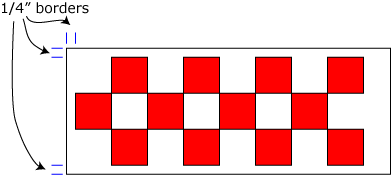
Without removing the backing, arrange 12 tiles in a checkerboard on one white arm. Place the tiles so there is a ¼" white border along the sides and at one end. Start at one end by placing a single 1" tile ¼" from the end, centered. Place seven more rows of 1" tiles in alternating rows of two and one to form a checkerboard on the white background.
When you are satisfied with the checkerboard arrangement, carefully remove the backing from each tile, one by one, and press in place. Repeat for the three arms.
Tip: Laying a ruler along one side of the arm, overlapping the edge by ¼", will make placing the tiles in a even line easier. A clear ruler with ¼" rules works very well as a guide.
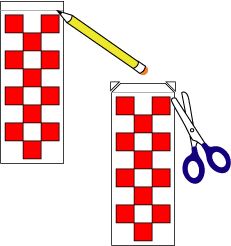
The four arms meet in the center and are held in place by the large red felt squares. Use a pencil and ruler to mark a line ½" in from the top end of each arm (the end with the wider white border). Cutting from the marked line toward the top, snip off each corner of the top end at a 45° angle.
Arrange the four arms in a cross, abutting the snipped corners. The four marked lines should form a 3½" square; make adjustments if needed. Remove the backing from one of the 3½" red squares, and carefully apply it over the abutted arms and marked square. Press firmly in place and rub to ensure a good hold. Flip the board over and apply the other 3½" red square to cover the backside of the joins.
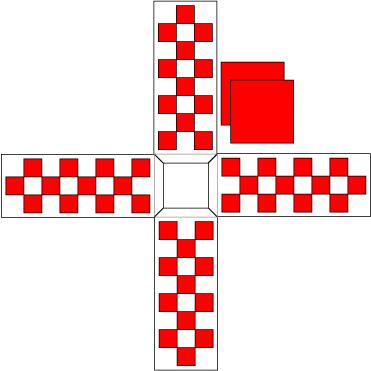
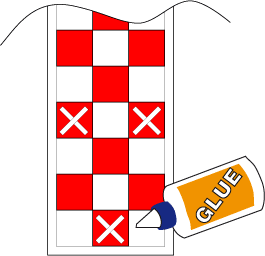
Three spaces on each arm, called castle squares, are marked with an "X". Use tacky glue or fabric glue to glue two 1" x 1/8" white strips in an "X" on the center red square at the end of each arm, and on the two red squares on the fourth row from the end on each arm. Set aside to let the glue dry.
If you like, embellish the game board with felt cutouts or embroidery.
Pachisi game boards are usually folded for storage. Cut a 24" length of ribbon in a coordinating color to use as a tie. Fold each arm in half, and then fold two arms over the center square and fold the other two arms back under the center square. Tie the bundle together with the ribbon in a loose bow.
To play pachisi, you will need a game board and four sets of four playing pieces (traditional set colors are black, yellow, green and red), and six cowrie shells. You can use playing pieces from other games, mini-marshmallows or cereal (Cheerios, Kix, Trix). Two-sided dice or coins may be used in place of the cowrie shells. Or, you can make your own playing pieces and cowrie shells with homemade Modeling Dough.
Pachisi is a game for two or three players, or four players in two teams (usually, black and yellow versus green and red). The object of the game is to be the first player (or team) to move all pieces around the board and back to the center (char-koni).
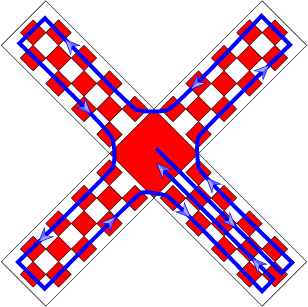
Tip: Remember, in a team, both players win or lose together! It is not a good idea for one player of a team to finish way ahead of his partner.
The game ends when one player (or team) moves all pieces around the board and back to the center (char-koni).
Your game board is done! Have fun
playing pachisi!
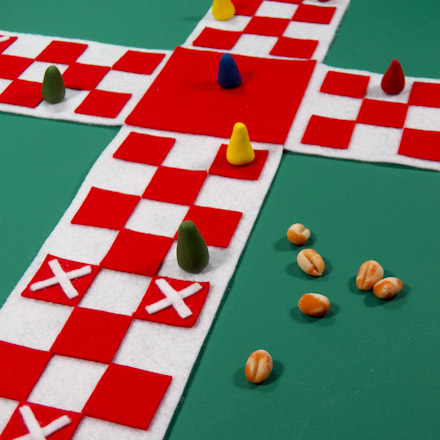
Pachisi and Asi Keliya have similar rules of play. For Asi Keliya you will need a game board and four sets of four playing pieces (traditional set colors are black, yellow, green and red), and five cowrie shells—four yellow and one white.
Asi Keliya is a game for four players in two teams (usually, black and yellow versus green and red). The object of the game is to be the first team to move all eight of their pieces off of the board.
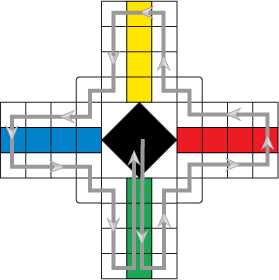
Tip: Remember, in a team, both players win or lose together! It is not a good idea for one player of a team to finish way ahead of his partner.
When one team has removed all eight pieces from the board, they are the winners.
Race games played on cruciform boards originated in India. They have spread from there to all over the world. The most popular of these games is pachisi, which translates to "twenty-five". The game is played on a cross-shaped board with 3 x 8 (24) squares in each arm. The central square is called the char-koni (throne). Boards are usually made of decorated cloth.
Pachisi is called the national game of India. The rules vary from one part of India to another. Pachisi originated in India during the sixth century, or even earlier. Traces of pachisi boards carved in stone are still visible at the ancient temples of Ellora in the Deccan region of India. It is traditionally played with dome-shaped playing pieces and cowrie shells. A variation of pachisi, called chausar, is played with three oblong, four-sided dice. Chausar are marked on opposite sides with 1 and 6, 2 and 5.
Chinesenspiel means "game of the Chinese" in German. It is a simple children's game based on pachisi. At the time that the game originated (19th century) in Germany, Chinese things were in fashion. No one seemed to care that this was really a game of India.
Asi keliya (the shell game) is played throughout Sri Lanka. It is also called sonaru ("four-four").
A race game that originated in Korea is called Nyout. It has been played for thousands of years, and it is also played in other parts of Asia. There is even some evidence that the game spread to North America from Korea. The game can be played with just about any number of players, but is most often played by four players in teams of two.